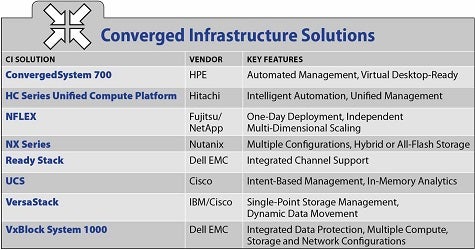Converged Infrastructure (CI) is one of those things that is easy to understand but rather difficult to define. Unlike traditional data center environments, convergence breaks down the hard lines between compute, storage and networking to create a more flexible, federated data environment.
This not only lowers costs but provides for simpler deployment and management of the data ecosystem, which is more in tune to the dynamic world of application- and service-centric workflows.
The problem arises, however, when we start to approach the line between convergence and hyperconvergence (HCI), which places all infrastructure on a modular, usually commodity-based footprint in which actual data environments are defined strictly in software. While it may seem logical that convergence is the in-between step in the migration from traditional infrastructure to hyperconvergence, this is not necessarily the case.
According to Trey Layton, senior vice president of engineering for CI at Dell EMC, the difference between CI and HCI lies in the way the enterprise plans to scale infrastructure going forward.
“HCI is a symmetrically scaling architecture,” he said. “When you need power, compute, networking, you add a node so that all performance scales symmetrically. CI is an asymmetrically scaling architecture; if you want to dial up larger capacity of storage, simply add disks to the storage array. If you want compute, simply add compute nodes.”
In this way, neither solution is correct for all use cases, which means the enterprise needs to take a hard look at both its current and future data objectives in order to devise the proper infrastructure. In fact, organizations with highly complex data needs will likely come to rely on a mix of traditional, converged and hyperconverged infrastructure.
“Our perspective on the market since the introduction of HCI products is that this is not an ‘or’ conversation, it’s an ‘and’ conversation,” Layton said. “There are infrastructure traits and then there are application traits that determine which solution is warranted.”
What kinds of applications are best suited to asymmetric CI environments? Layton says there are no hard and fast rules, but in general you can expect CI to accommodate the very large, complex apps that drive critical business functions: financial tools, ERP, warehousing, transactional and the like. HCI is better at accommodating smaller, more compartmentalized functions like many of today’s web tools, marketing campaign systems, archival and devtest.
“Our objective is to continually enhance CI architectures and their underlying components so they are optimized for new classes of more modular applications,” Layton said. “There will be apps that fit like two pieces in a Tetris model, and then apps that require a multitude of infrastructure capabilities and performance variables that are leaning more toward asymmetric infrastructure.”
Without doubt, there will be enterprises that migrate to 100 percent HCI and others that maintain diverse infrastructure. The key determinant, it seems, is to tailor the compute environment to application needs and overall business objectives – a distinct break from today’s practice of deploying the technology first and then deciding how to use it later.
Below are some of the leading converged infrastructure solutions:
HPE ConvergedSystem 700
ConvergedSystem 700 is billed as an open, modular and scalable platform that is purpose-built and factory integrated for virtualization, hybrid cloud and workplace productivity use cases. The system incorporates key HPE products, like the FlexFabric Ethernet connectivity solution and OneView automation engine, as well as Cisco’s Nexus 9000 switch.
Hitachi HC Series Unified Compute Platform
The HC Series features automation provisioning and orchestration that allows users to spin up virtual environments in minutes. It supports traditional and cloud-native applications with high-speed NVMe SSD storage, and can be deployed under a linear scalability strategy that allows organizations to gradually expand nodes as data needs require.
NetApp NFLEX
NFLEX leverages key technologies from Fujitsu and NetApp, including the Primergy CX and NetApp AFF and FAS storage modules. It also incorporates switching technology from Extreme Networks and is preconfigured for VMware vSphere environments. Operations are streamlined through the Fujitsu ServerView ISM stack that combines server, storage and networking management under a single interface.
Nutanix NX Series
The NX Series comes in a range of models, each with variable configuration options built on a 2 RU form factor. Systems are built around Intel Broadwell or Skylake processors, with storage scaling into the petabytes. Top-end systems support 25 and 40 GbE connectivity on either SFP+ or QSFP+ cabling.
Dell EMC Ready Stack
Ready Stack is a reference architecture designed to help channel partners deliver integrated CI solutions. The package features a range of compute, storage, networking and data protection products, all compiled under a trusted integration program that stresses both speed and flexibility of deployment.
Cisco Unified Compute System (UCS)
The UCS platform is fully programmable and features a policy-based fabric management solution that streamlines provisioning, load-balancing and other tasks. It also features endpoint aware I/O virtualization to accommodate the needs of containerized and IoT workloads.
IBM VersaStack
VersaStack incorporates multiple IBM and Cisco products, such as the FlashSystem and Storwize memory modules and Nexus switching. It also features real-time compression and advanced storage tiering for improved data management, as well as a dynamic capacity management solution to adjust resource consumption to data needs.
Dell EMC VxBlock System 1000
VxBlock combines technologies from Cisco, VMware and Del EMC to enable multiple configurations and capabilities. The company says it can reduce the cost of IT operations by 61 percent and produce a 640 percent ROI over five years.
Arthur Cole writes about infrastructure for IT Business Edge. Cole has been covering the high-tech media and computing industries for more than 20 years, having served as editor of TV Technology, Video Technology News, Internet News and Multimedia Weekly. His contributions have appeared in Communications Today and Enterprise Networking Planet and as web content for numerous high-tech clients like TwinStrata and Carpathia. Follow Art on Twitter @acole602.



